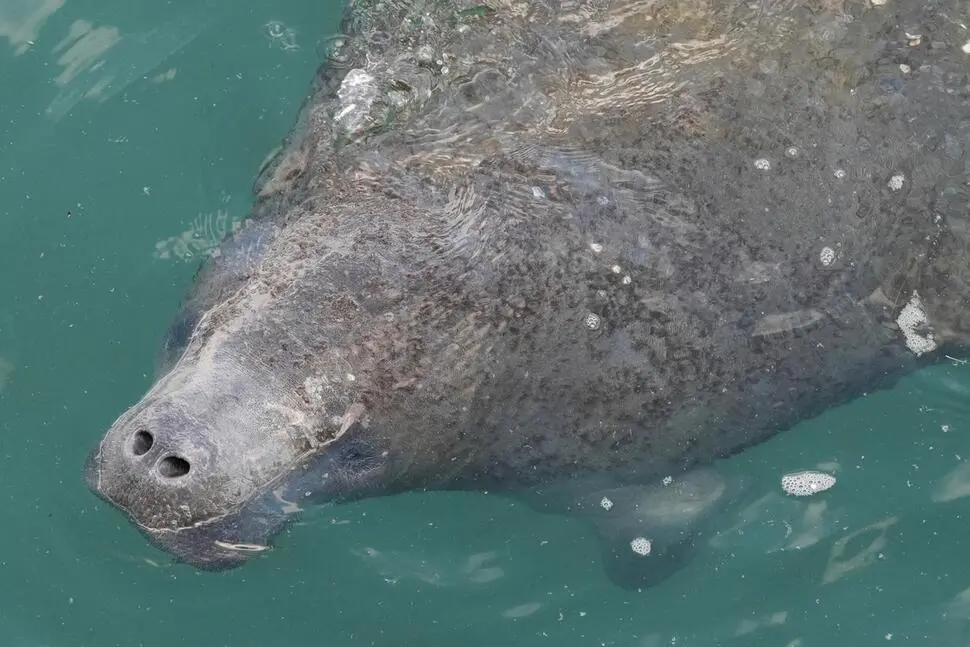A polar vortex that has hit much of the U.S. with ice and snow has dealt a glancing blow to Florida and its manatee population
RIVIERA BEACH, Fla. (AP) — A polar vortex sweeping across much of the U.S. has had an unusual impact on Florida, where coastal temperatures have dropped and prompted the Sunshine State’s manatee population—still recovering from a past mass starvation event—to seek refuge in warmer waters.
Manatees, after relying on inland natural springs for warmth, have long been drawn to the warm-water discharges from power plants across Florida. For decades, these aquatic mammals, taught by mother manatees, have followed a travel route to various power plants. In addition to locations in Riviera Beach, Fort Myers, and Apollo Beach, public viewing areas provide a chance for visitors to see the animals up close.
For the past week, dozens of manatees have gathered near the Florida Power & Light Company’s Riviera Beach plant. The plant is home to the Manatee Lagoon, a public attraction that opened in 2016. The facility is hosting its family-friendly ManateeFest on February 1.
“These gentle giants are vital indicators of environmental health,” explained Rachel Shanker, the Manatee Lagoon education manager. “As sentinel species, manatees give us early warnings about any issues affecting water quality or the broader environment. Their charismatic nature also makes people take notice of the changes happening around them.”
While Manatee Lagoon is open year-round, the best time to view the animals is from November 15 to March 31, when Florida’s water temperatures can fall below 68 degrees—temperatures that pose a serious risk to manatees. Though boating accidents are the leading human-related threat to manatees, cold stress remains one of their primary natural dangers.
“The warm water produced during power generation attracts manatees, who seek warmth when the air turns chilly,” Shanker explained.
The power plants use bay water to cool their systems, and no chemicals are added to the water, making it safe for the manatees and other wildlife. The warm water they discharge is simply the same ocean water, only heated.
While the number of manatees fluctuates, Shanker reported that around 85 have been counted this year at the Riviera Beach plant.
“Manatees come to Manatee Lagoon for the warmth, but there isn’t much seagrass here, so once they get hungry, they head out to find their food. After feeding, they return to our warm waters,” she said.
In 2024, Florida saw 565 manatee deaths, consistent with the previous year’s numbers. However, this represents a significant drop compared to 2021, when over 1,100 manatee deaths were recorded, primarily due to starvation. The loss of seagrass—caused by pollution from farms, urban runoff, and other sources—was a key factor in the mass die-off.
“The biggest problem was in the Indian River Lagoon, where algal blooms degraded the water quality, causing seagrass to die off,” said Martine de Wit, a manatee veterinarian with the Florida Fish and Wildlife Conservation Commission (FWC). “This affected many manatees in the area.”
Indian River Lagoon, located along Florida’s central Atlantic Coast, is home to a significant portion of the state’s manatee population, with over 8,000 manatees in total. At least one-third of them live or migrate through the lagoon.
In response to the seagrass crisis, wildlife officials began feeding manatees lettuce to help alleviate the worst effects. Since then, the seagrass has begun to recover, and manatee deaths have decreased.
“Seagrass is resilient, and it bounced back on its own,” de Wit said. “Manatees have been able to find it again.”
While deaths have declined in recent years, 2024 saw a rise in the number of dead manatee calves. De Wit explained that after years of malnutrition, many manatees were physically unable to reproduce. But as the seagrass returned, these once-starving animals began reproducing in large numbers.
“When you have higher pregnancy rates, more manatees are born, but unfortunately, some don’t make it,” de Wit noted. “This was expected, as it was a result of the population bouncing back after years of lean times.”
Despite progress, the U.S. Fish and Wildlife Service recently rejected calls from Florida environmental groups to reclassify the manatee as endangered. In 2017, the species was downgraded to threatened, and it will remain at that classification.
While the manatee population in Florida is on the mend, conservation efforts must continue, according to de Wit.
“We can’t relax just yet,” she said. “There are still significant threats to manatees, and ongoing management is crucial to their protection.”
